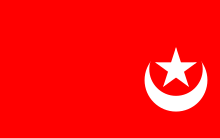Yakut Khan
| Qasim Yakut Khan | |||||
|---|---|---|---|---|---|
| First King Of Janjira State | |||||
 Flag Of Janjira State | |||||
| Born | Patil Of Guhagar Guhagar | ||||
| Died | 1733 | ||||
| |||||
| Father | Patil Of Guhagar | ||||
| Religion | Muslim | ||||
| Occupation | Jagirdar Of Janjira State, Admiral Of Mughal Navy | ||||
Qasim Yakut Khan also known as Yakut Shaikhji, Yakub Khan and Sidi Yaqub was a naval Admiral and administrator of Janjira Fort who first served under Bijapur Sultanate and later under the Mughal Empire.[1]
Family[]
He was born into a Koli family which was Patil of Guhagar.[2] He was jailed at a young age and later grew up in a Siddi Muslim family. There, he got his new name as Qasim Khan and after becoming admiral of the Mughal navy, he was titled Yakut Khan by Emperor Alamgir.[3][4]
History[]
In October 1672, Khan entered the seven islands of Bombay and attacked the Marathas with whom they were at war. Khan returned the following year, on 10 October 1673, after destroying the towns of Pen and Nagothane.[5]
Yakut Khan, along with Siddi Khariyat Khan & Siddi Sambal, had earlier saved the Portuguese from the Marathas left by Sambhaji at Chaul. In return, they enjoyed a cordial relationship in the otherwise tense political climate.[5]
In 1689, the Mughal Emperor Aurangzeb ordered Khan to attack Bombay for the third time after Indian vessels sailing to Surat were captured in 1686 (Child's War). In April 1689, the strong Mughal fleet from Janjira commanded by the Sidi Yaqub and crewed by Mappila and Abyssinians laid siege to the British fortification to the south.[6][7][8]
After a year of resistance, the English surrendered, and in 1690 the British governor Sir John Child appealed to Aurangzeb. In February 1690, the Mughals agreed to halt the attack in return for 150,000 rupees (over a billion USD at 2008 conversion rates) and Child's dismissal.[9] Child's untimely death in 1690 however, resulted in him escaping the ignominy of being sacked.[10]
Enraged at the agreement, he withdrew his forces on 8 June 1690 after razing the Mazagaon Fort.[9]
Later, the Ganj-i-Sawai and other Mughal vessels, were captured by the pirates Henry Every and Thomas Tew.[11][full citation needed] One of the Maratha forts was captured after he granted amnesty to the garrison. The captured men were killed.[12]
Khan died in 1733.[5]
References[]
- ^ The African dispersal in the Deccan: from medieval to modern times, By Shanti Sadiq Ali, Published by Orient Blackswan, 1996,Public Domain, ISBN 81-250-0485-8, ISBN 978-81-250-0485-1
- ^ The Indian Historical Quarterly (see page 234). Ramanand Vidya Bhawan. 1985.
- ^ Palsokar, R. D.; Reddy, T. Rabi (1995). Bajirao I: an outstanding cavalry general. Reliance Pub. House. ISBN 9788185972947.
- ^ Ali, Shanti Sadiq (1996). The African Dispersal in the Deccan: From Medieval to Modern Times. Orient Blackswan. ISBN 9788125004851.
- ^ a b c Yimene, Ababu Minda (2004). An African Indian Community in Hyderabad: Siddi Identity, Its Maintenance and Change. Cuvillier Verlag. p. 204. ISBN 978-3-86537-206-2.
- ^ State), Bombay (India (1883). Gazetteer of the Bombay Presidency ... Government Central Press.
- ^ Ali, Shanti Sadiq (1996). The African Dispersal in the Deccan: From Medieval to Modern Times. Orient Blackswan. ISBN 9788125004851.
- ^ Faruki, Z. (1935). Aurangzeb & his times. Idarah-i Adabiyāt-i Delli.
- ^ a b Nandgaonkar, Satish (22 March 2003). "Mazgaon fort was blown to pieces – 313 years ago". Indian Express. Express Group. Retrieved 20 September 2008.
- ^ Prakash, Om (1987). European Commercial Enterprise in Pre-colonial India. Cambridge University Press. ISBN 978-0-521-25758-9.
- ^ Europe, 1450 to 1789: Encyclopedia of the Early Modern World
- ^ Growth under the Mughals India Muslims: Who Are They?
- History of Mumbai
- Koli people
- Mughal generals
- Indian history stubs